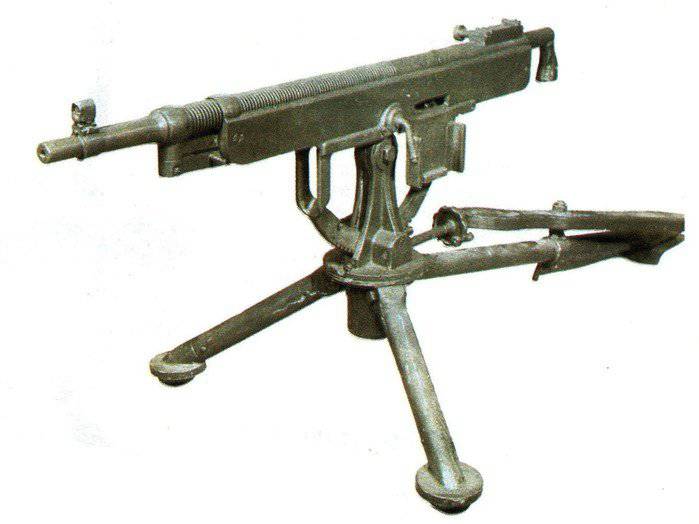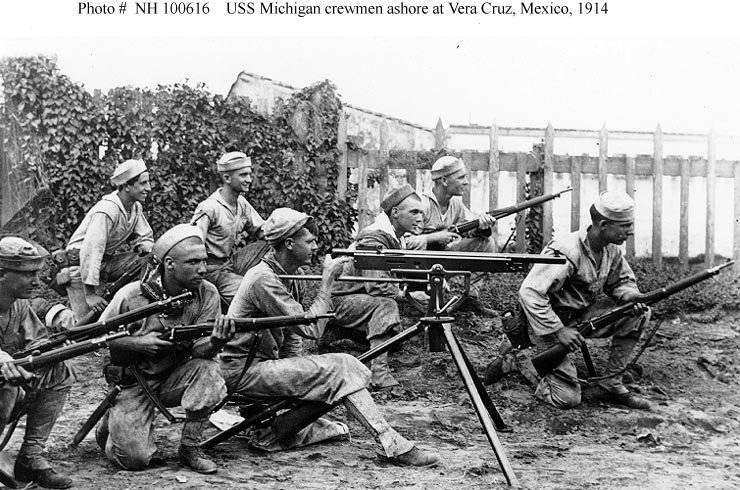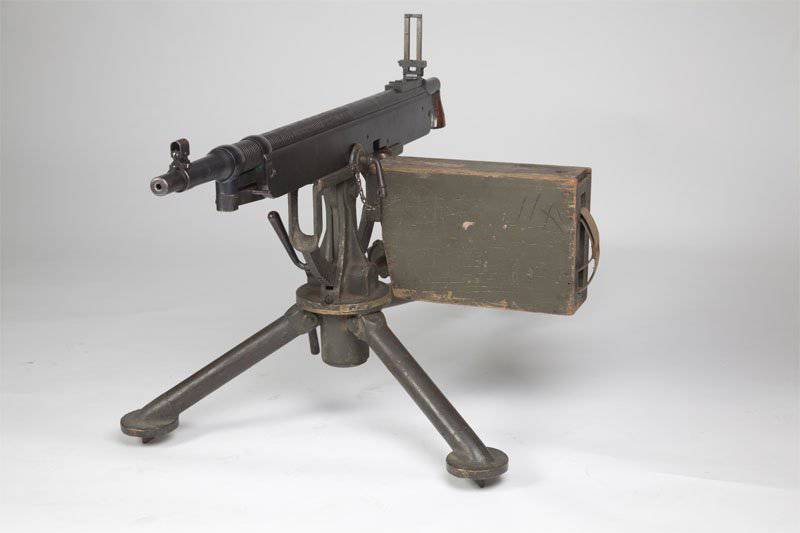Machine gun М1895 / 1914 "Colt"

Vapor engine was the original circuit. Powder gases, after their passage through the open hole in the wall of the barrel from the bottom, discarded the piston, fastened at the end of the long arm of the connecting rod - swinging crank arm. The rod, turning on 170 degrees, set in motion a bloodworm (second lever) connected with a slide through a sliding bar. Planck (bolt carrier) was the leading element of the system. She, moving back, worked on the protrusion of the bolt figured neckline. After lowering, the rear part of the bolt was disengaged from the supporting surface of the receiver - the barrel bore was unlocked. Planck, while continuing to move, took the bolt back, and the sleeve was removed from the chamber of the spring-loaded ejector valve. The sleeve struck against the receiver liner tooth that slid into the slot of the bolt and was pushed to the right through the exit window in the receiver. At the same time, a pair of return springs mounted in the tubes under the barrel was compressed. Hinged earrings and rods connected the springs and the short rod of the connecting rod, turned it forward, returning the moving system to its original position, the bolt delivered the cartridge to the chamber, and if the trigger was pulled, the next shot was fired. The stroke length of the system was equal to 102 millimeters. Due to the characteristic movement of the piston and the dust raised by the exhaust gases, the machine gun M1895 / 1914 "Colt" got the nickname "Potato Digger" - "potato digger". It was believed that the air intake after each shot made improved the cooling of the barrel, but in reality it provided only a purge of the vent hole.
In the tubular back plate, the trigger mechanism was set up with a helical combat spring and a rectilinear movement of the trigger. The trigger included a self-timer and an open trigger. On the right side of the installed safety lever, which locked the trigger. The reloading handle was under the piston at the end of the connecting rod. The cord was manually tied to this handle for reloading, and the other end was attached to the back plate. However, there was a more convenient scheme, which has a swinging lever and a block. On the back plate there was a control handle.

Power machine gun made from canvas cartridge belt, designed for 100 ammunition. The power supply system consisted of a drum-type receiver driven by a sliding bar, an extractor, and a cartridge feeding device. The drum had two notches - the front seized the cartridge in the tape for the bullet, the back - for the sleeve. The swinging feed lever rotated the drum. The lever was mounted in the right wall of the receiver and connected by a swinging feeder. Turning the drum to the right was not allowed by a special dog. The cartridge was held in the chamber of the tape as follows. While the plate was moving backwards, its protrusion pressed on the tail of the feeder, which led the feed lever. The tail of the feeder jumped over the tooth of the drum, without rotating it. During the reverse movement, the part slats were reversed, while the tooth of the feed lever rotated the drum one step and the cartridge was in front of the receiver window. The cartridge from the tape was removed for the rim of the spring-loaded extractor. The extractor was mounted on a strap and moved the cartridge to the tray of the feed fixture. After the chuck crest was completely removed from the tape, it pressed on the dog of the tray that raised the cartridge to exit the frame window, the retriever released the cartridge at that time, and the tray stopped moving so as not to interfere with the extraction of the spent case. During the return movement, the bar turned the tray, while the cartridge moved to the receiving window of the receiver, where it was picked up by the shutter. The comb at the time of entry of the cartridge into the chamber was emptying the tray dog, and the tray was lowered. The protrusion strap pressed on the feeder, and the next cartridge was fed with a drum. The design of the machine gun had 137 details.
The machine gun was mounted on a tripod machine consisting of a base, to which one rear and two front legs were attached (hingedly), a swivel, a swinging part, a worm gear with a serrated arc for vertical laying. The body of the machine gun was mounted on the platform of the swinging part with the aid of a deadbolt and a regulating screw; the holder of the cartridge case was on the left side of the platform. On the back foot was installed a swiveling transverse bar with elbow supports (“low” tripod) or a seat and bag with spare parts (“high” tripod).
In August, the 1915 of the year after testing the “Colt of the 1914 model of the year” machine gun at the Gunnery range of the Officer Rifle School, Major General Filatov, the head of the school, wrote: “It’s very difficult for one person to load a machine gun ... The variety of breakdowns and their relatively large number indicate low strength of its parts. " As it often happened, the order from Russia required an improvement of the sample. For example, the first 1750 machine guns were supplied with a high so-called “French” tripod (the Colt company supplied such a tripod to France), and the slide was reinforced on them. General Sapozhnikov made considerable efforts to ensure that the Colt and Marlin began to supply "low" tripods. It turned out that the shields, whose dimensions were 685x445 millimeters, are more reliable to do at the Izhora plant in Russia. For them, used 6,5-mm armored steel.

The machine guns of the “Russian order” were equipped with a folding frame sight, notched to 2300 meters, with the entire dioptric — the lug of the sight had a disc with five diopter holes, which were selected depending on the light and distance. The sight was equipped with a mechanism for introducing lateral corrections. The length of the aiming line was 855 millimeters.
The Colt machine gun found its place in the Russian aviation. On October 4, 1915, General Sapozhnikov, especially for aviation, bought 67 Colt machine guns (7 mm caliber) and a million rounds of ammunition in cash. April 30, 1916 they were transferred to the Aeronautical Department of the GVTU. However, shortly after this, the GVTU returned some machine guns to the GAU to be adapted for firing incendiary bullets.
At the end of 1915, a tripod with a seat, a replaceable copper drum with a tape, and a wooden butt-handle were offered to the Colt machine gun. This installation was not used in the infantry, but the butt and drum were evaluated in aviation - drums with fastening, as well as bags for spent cartridges were ordered at the V.A. Lebedev. " The Russian-Baltic Carriage Works produced synchronous installations for the Vickers and Colt machine guns. In 1918, the Marlin company released its aviation modification of the machine gun (with a gas engine and linear piston movement), and later tank - This machine gun was not delivered to Russia.
The order of unloading machine gun M1895 / 1914 "Colt": The button of the arrester located on the right side of the box to move forward, freeing the feed drum. Pull out the cartridge belt to the left.
The order of the partial disassembly of the machine gun M1895 / 1914 "Colt":
1. Removed the barrel. For this: moth is retracted down and back. Holding it in the final position, pull the barrel latch located at the base of the gas chamber with a screwdriver. Using the same key, insert a tooth into the slot on the barrel, unscrew and remove the barrel. Smoothly lower the bloodworm.
2. Separated back plate. To do this, turn back the backstop shutter located on its right side, remove it to the right, holding the control handle, remove the backplate back swinging it up and down.
3. Understands the back plate. To do this: pressing the trigger with a tooth of an automatic trigger, gently separate the parts.
4. Removed the shutter. For this it is necessary to take the bloodworm to the rear extreme position and, thus holding it, by the tail of the contactor, push the bolt axis through the hole in the left wall of the buttbox box; release the crank and take out the shutter.
5. Understands the shutter. To do this, the stud of the drummer is pushed out and the drummer with the spring removed.
6. The machine gun is separated from the machine. For separation, you need to turn the connecting bolt up with the handle and remove it; the machine gun body is removed from the machine.
Assembling a machine gun in the reverse order.
Specifications of machine gun "Colt" sample 1914 of the year (М1895 / 1914 "Russian order"):
The cartridge is 7,62 of the model 1908 of the year (7,62x53);
The mass of the "body" machine gun - 16,1 kg;
The length of the "body" of the machine gun - 1050 mm;
Barrel length - 700 mm;
Grooves - 4 right;
The length of the stroke rifling - 240 mm;
Initial bullet speed - 850 m / s;
Sighting range - 2300 m;
The rate of fire - 500 shots per minute;
Combat rate - 200 shots per minute;
Tape capacity - 250 cartridges;
Type of machine - tripod (the so-called "low tripod");
Machine weight - kg 23,9;
Shield weight - 12,4 kg;
The angle of vertical guidance is from -40 to + 30 degrees;
The angle of horizontal guidance - 360 degrees;
The height of the line of fire - 494 mm.
Based on: S. Fedoseev - Machine Guns in the First World War
Information